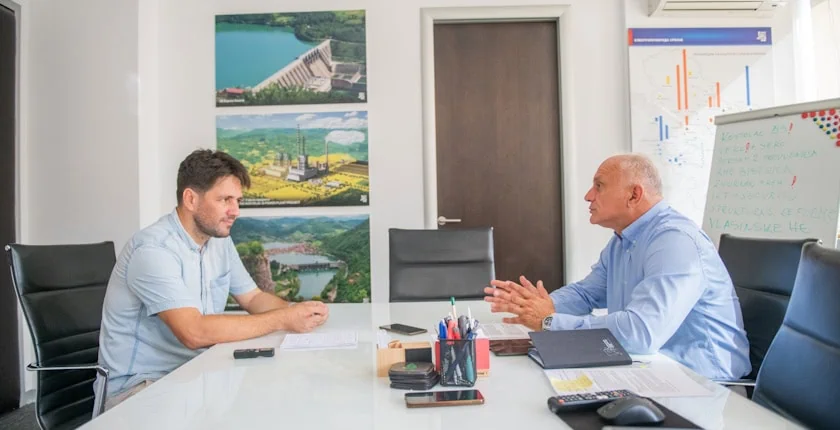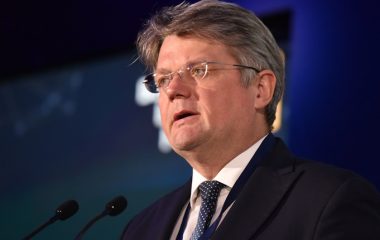
Dušan Živković (left) in talk with our journalist (photo: EPS)
The energy crisis has changed the game rules for energy companies so, like others, Serbia’s state-owned power utility Elektroprivreda Srbije (EPS) must adapt to survive and obtain profit, but also ensure the country’s energy security, General Manager Dušan Živković said. The need for a shift was constant, but there was no strong incentive, he pointed out. New electricity producers are now emerging in the market including companies and citizens, the CEO added and stressed it was unseen before.
In an interview with Balkan Green Energy News on the transformation of Elektroprivreda Srbije (EPS), Dušan Živković also revealed whether the Bistrica pumped storage hydropower plant would come online by 2032 and when the company would complete its decarbonization. He also provided insight on the utility’s preparations for the rollout of the CO2 levy within the European Union’s Carbon Border Adjustment Mechanism and plans to cut the emissions of air pollutants from thermal power plants to European standards.
Serbia reached a record-high daily power consumption of 108 GWh in July, a level that was unthinkable until several years ago. Nevertheless, the most important thing is that EPS managed to maintain the stability of supply. But how is EPS going to alter its business activities with a view to adapt to the new reality?
Most importantly, we managed to secure sufficient quantities for consumers. The summer period is becoming nearly equally challenging in consumption terms as the winter one. Therefore good preparation is needed for the summer, too, and not just for the winter. In addition, the summer is an even drier season than the winter period, so hydropower output is significantly lower.
Do overhauls need to be planned differently and, on that note, what about power procurement?
It’s a completely new reality. Spring and autumn will now be the periods where overhauls must be conducted, and the system will need to be available, which includes obtaining some quantities in the market.
Currently the most important project for EPS is the Bistrica pumped storage hydropower plant (PSHPP), with 628 MW in planned capacity. How far did the implementation reach?
PSHPP Bistrica creates long-term conditions for facilitating growth in our usage of renewable energy sources and the balancing potential. The project is in a preparation stage, together with the Japanese side, considering that conditions have been met to obtain approval of the Japan International Cooperation Agency (JICA) for financing.
The biggest problem for Bistrica project could be the fact that currently the market lacks companies that can approach a job seriously and responsibly and complete it within the deadline
The following steps for us are to select a consultant and prepare the tender documentation regarding the choice of equipment. We expect the environmental impact assessment study to be adopted by October. We are within schedule here.
In the recently published Draft Energy Sector Development Strategy of the Republic of Serbia up to 2040, PSHPP Bistrica is supposed to come online in 2032. Will it?
That is currently the objective and no deadline is jeopardized.
What could be the problem?
The biggest problem currently in the market is the lack of companies that can approach a job seriously and responsibly and complete it within the deadlines. The disturbances in the energy sphere in 2021 didn’t only jeopardize energy companies but also supply chains. We are often found in a situation where the world’s best companies stop being available and reliable enough.
EPS always worked under the best available techniques or BAT principles, which only the best companies have now that they are facing new challenges.
You don’t expect problems in the field with regard to environmental protection? What are the reactions of the people living near the location where the PSHPP will be built?
We send each part of the environmental protection study that we finish to the Japanese partners as well, so that they can also conduct their procedure.
They are being informed and there is no problem. Everyone sees it as a potential, too. An investment of EUR 1 billion in any part of Serbia is a significant project and a great potential for its development. Especially for some rural parts like this one.
Besides the investment itself, the project will bring diverse options like tourism, food production…
Negotiations are underway with strategic partners on a project for solar power plants with a total capacity of 1 GW, which EPS will inherit one day. However, what do you plan to do independently in the segments of solar, wind, batteries?
The most cost-effective option for EPS is to use its own locations like ash dumps, as there is no expropriation and, on top of it, it is the most ecological way possible, as the landfill is recultivated and solar panels are installed. The projects are for 40 MW at thermal power plant (TPP) Morava, 70 MW at TPP Kolubara, 100 MW at the Kostolac thermal power plant complex and 200 MW within the Termoelektrane Nikola Tesla (TENT) group.
The turbulent situation in the market have slowed down the installation of Kostolac wind farm
We still need to produce documentation, obtain permits and financing before beginning construction works.
From the example of EPS’s first wind park – Kostolac, being built for some ten years now and envisaged with 66 MW in capacity, it is clear that everything took too long. Why?
This project too ran in parallel with global problems that energy companies faced in the market, but also the problem of workforce fluctuation, which is why the contractor’s experts initially didn’t cope with the project preparation. We also had global changes in the market, company acquisitions, changes in ownership structures and completely new situations – weakening in availability, competence and reliability, together with a significant rise in market prices deriving from instability in the energy market. Finally, even the cost-effectiveness of some projects came into question.
Were there any problems in EPS?
No.
Which solar power plant of the ones that you mentioned should come online first?
The Morava and Kolubara could probably be the ones. The locations are on ash dumps. The is the Petka facility before others, but it is already in the construction phase, and it should be on the grid next year.
What are the plans for batteries?
Batteries are important to enable short-duration storage, at a two-hour level. They will follow the solar units and, if we think we need it, we will install it. We will have 200 MWh in batteries within the 1 GW project.
Such a big project could make up for the years when EPS wasn’t developing wind and solar project and to secure for it a serious renewables portfolio if we are looking at the whole region.
Yes, we should take it over in 2028/2029. It will be especially important for this period, the summer, to cover consumption daily with the production of green energy and that way significantly reduce the effects of increased consumption due to the use of air conditioners.
Green energy production is slowly increasing, but what will happen to thermal power plants that use coal? The abovementioned draft strategy stipulates that Serbia would decarbonize its energy production. Will EPS be decarbonized by then?
Those are the plans, it is realistic and we must strive for it. This century should bring a new technology era, one that is energy intensive. But it is financially demanding as well. Serious investments are necessary to complete the decarbonization process.
It is realistic to have decarbonized EPS by 2050
We have renewable energy targets and for 2030 it is a share of 45%. I think that through the 1 GW project and our projects reach the 2030 objective relatively easily. But then comes a more challenging period, until 2040, because we will have to make decisions to secure baseload energy, also implying nuclear energy.
It seems the main question is how to conduct decarbonization while enabling energy security.
When energy companies started becoming more and more profitable, investment decisions were shifted to the tip of the razor, toward increasing profits, but basic things like infrastructure were forgotten. The crisis sobered everyone up. Energy security became every country’s imperative.
Serbia will need to face it, too. It means we are self-sufficient, if we have the resources, and if we don’t, to diversify with quality, not keep all the eggs in one basket. Some gas, some coal, some sunlight and wind, some hydrogen and nuclear power plants and to have a sufficient amount of energy in this century like we had in the last one.
Do you consider nuclear energy to be a serious option for Serbia?
That is the key topic – should Serbia limit the development of its energy sector? I think it shouldn’t. A lack of options means a lack of safety. We must be open to all ideas, like nuclear power plants, but at the same time understand both the place and the role of all four thousand or so prosumers in the Serbian energy market.
EPS must be open to all ideas – nuclear power plants, or prosumers
It shows that the citizens of Serbia are interested in being part of the electricity production market and being responsible for the future of energy in Serbia. And also worthy of the point in time that the energy sector is in, in an intergenerational sense, and the important decisions, like our fathers were when they followed Tesla’s ideas dating from early in the previous century.
It seems that state-owned firms have a hard time accepting that. They see prosumers as competition, as an obstructing factor.
The time has come for energy companies to coexist with other companies. We are on the same path, both sides are on the decarbonization path. Private capital always finds its way, contributing that way to energy security.
Currently the European Union’s Carbon Border Adjustment Mechanism (CBAM), a tax on imports of CO2, is inevitable on that path. It will be rolled out in 2026. How ready is EPS?
We have to be ready. EPS will be partially exposed to CBAM, to the extent of how much it exports to the EU. Export-oriented companies will be more affected. They will tend to lower the CO2 footprint in final products as much as possible.
But does it mean they won’t buy power from EPS, power from thermal power plants that burn coal?
They will buy electricity from renewable sources, which EPS also produces. Such firms are looking for solutions both for energy production and the application of circular economy principles.
CBAM is greater problem for companies
And you don’t see any problem for EPS?
Not for EPS. I see it for companies, but they are preparing for it. EPS will methodically proceed on the planned path. Whether to export somewhere, or sell here, or in some regions where there are no such taxes. We applied in February into the CBAM mechanism, but we are waiting for 2026 to see what would happen.
EPS will need to adjust. How much will the recently adopted transformation plan help with that? What does it envisage?
The key event is the energy crisis, which has changed the game rules for energy companies. Workforce fluctuation is another reality. EPS must adapt to that, facilitate profit and energy security, develop and secure enough quality human resources, to enable decarbonization, but in an optimal manner.
Who guarantees that the plan will be materialized?
The traditional story is that we have to change, but there wasn’t any strong incentive so far. Now we had an energy crisis that showed that we have a completely different environment. In addition, we have decarbonization, digitalization, the circular economy. People and especially younger generations today complete everything through the phone. EPS must follow up on it, which means change, by looking for its place under the sun in a digital world and being a reliable partner in the energy market.
Changes in the energy sector are now very fast. It seems that the companies that deny it will disappear.
New players are emerging in the market. Companies and citizens, the prosumers, are energy players. There must be coexistence. It is possible that at some point, EPS will have power plants with 7,000 MW of production in its power plants on the other side of the meter, where consumption was, equivalent to the capacity of EPS’s all current power plants.
The government needs EPS to be capable of surviving in the market, to enable energy security in the years ahead
Energy companies need to adapt to the new world. But it is important to say that we also have the owner, the government, which needs EPS to be capable of surviving in the market, to enable energy security in the years ahead.
Because of CO2, decarbonization, digitalization and transformation, something very important for citizens is forgotten, and that is air quality. When will EPS’s emissions of air pollutants be cut to levels that match European standards?
A lot has been done. We will cover almost 90% of our thermal power plants with environmental protection measures. One of them, for example, is desulfurization in four units in TENT A and three in the Kostolac TPP. In the meantime we are waiting for the system in TENT B, as it is under construction. We expect it to be finished next year.
The remaining 10% are power plants where it doesn’t pay to do that, and they will probably be replaced by solar power plants.
One more thermal power plant is coming up – the third unit in TPP Kostolac B. There were announcements that the power plant would be commissioned last October. Are there delays in what was agreed with Chinese partners?
There are and there aren’t. The delays were caused by numerous situations, from understanding Serbia’s legal framework to the pandemic to the war in Ukraine. It would have been better if it had been completed six months ago, but it’s not easy to optimize such a big and complicated system.
Not a single power plant that big has been constructed in the last 30 years. There is a lot of equipment that needs to be commissioned and tested very carefully, and several different systems – coal delivery, boiler, turbine, generator, transformer unit, the switchyard. It all must fit with one another and run like clockwork, which takes time.
The unit is in a testing phase, with trial operation for each segment. Ten or so days ago we achieved 24 hours of operation for the first time at full power, of 350 MW, run by the control system. It can be said that it is the culmination of the trial operation. The plan is to commission it in October.


















Be the first one to comment on this article.